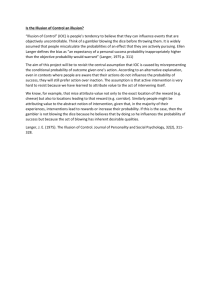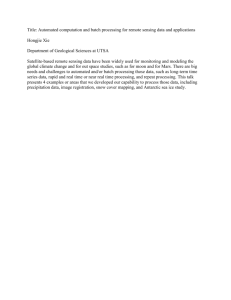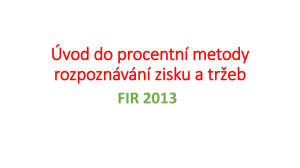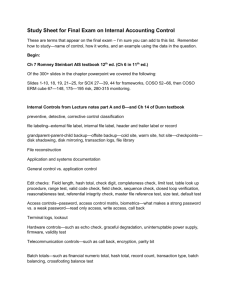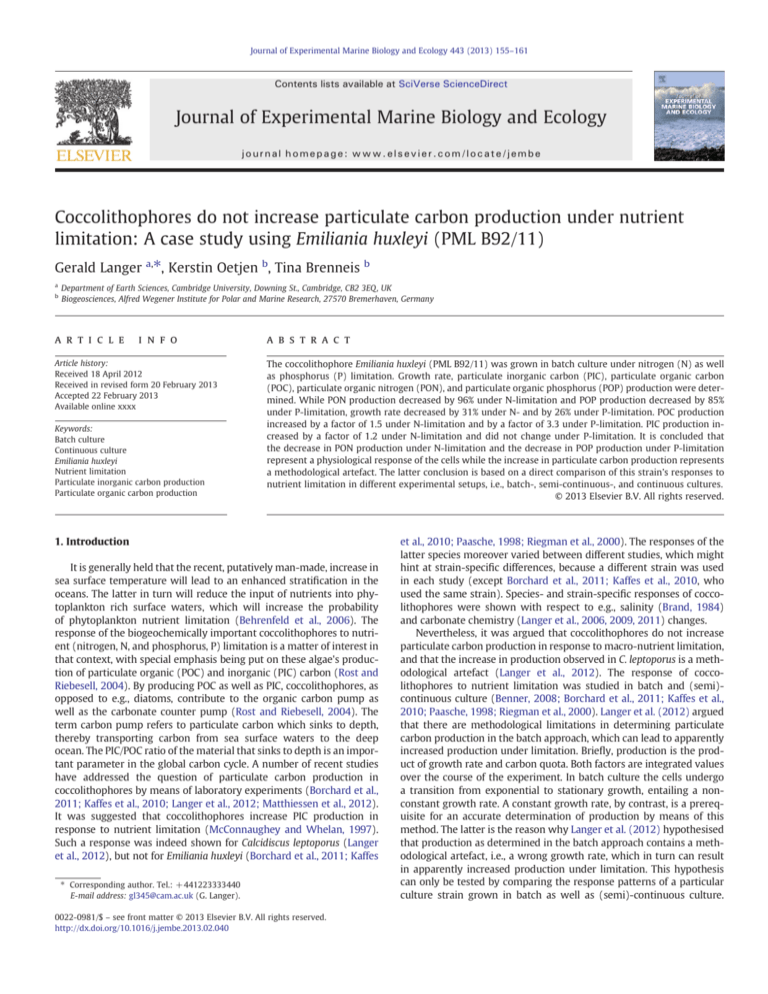
Journal of Experimental Marine Biology and Ecology 443 (2013) 155–161
Contents lists available at SciVerse ScienceDirect
Journal of Experimental Marine Biology and Ecology
journal homepage: www.elsevier.com/locate/jembe
Coccolithophores do not increase particulate carbon production under nutrient
limitation: A case study using Emiliania huxleyi (PML B92/11)
Gerald Langer a,⁎, Kerstin Oetjen b, Tina Brenneis b
a
b
Department of Earth Sciences, Cambridge University, Downing St., Cambridge, CB2 3EQ, UK
Biogeosciences, Alfred Wegener Institute for Polar and Marine Research, 27570 Bremerhaven, Germany
a r t i c l e
i n f o
Article history:
Received 18 April 2012
Received in revised form 20 February 2013
Accepted 22 February 2013
Available online xxxx
Keywords:
Batch culture
Continuous culture
Emiliania huxleyi
Nutrient limitation
Particulate inorganic carbon production
Particulate organic carbon production
a b s t r a c t
The coccolithophore Emiliania huxleyi (PML B92/11) was grown in batch culture under nitrogen (N) as well
as phosphorus (P) limitation. Growth rate, particulate inorganic carbon (PIC), particulate organic carbon
(POC), particulate organic nitrogen (PON), and particulate organic phosphorus (POP) production were determined. While PON production decreased by 96% under N-limitation and POP production decreased by 85%
under P-limitation, growth rate decreased by 31% under N- and by 26% under P-limitation. POC production
increased by a factor of 1.5 under N-limitation and by a factor of 3.3 under P-limitation. PIC production increased by a factor of 1.2 under N-limitation and did not change under P-limitation. It is concluded that
the decrease in PON production under N-limitation and the decrease in POP production under P-limitation
represent a physiological response of the cells while the increase in particulate carbon production represents
a methodological artefact. The latter conclusion is based on a direct comparison of this strain's responses to
nutrient limitation in different experimental setups, i.e., batch-, semi-continuous-, and continuous cultures.
© 2013 Elsevier B.V. All rights reserved.
1. Introduction
It is generally held that the recent, putatively man-made, increase in
sea surface temperature will lead to an enhanced stratification in the
oceans. The latter in turn will reduce the input of nutrients into phytoplankton rich surface waters, which will increase the probability
of phytoplankton nutrient limitation (Behrenfeld et al., 2006). The
response of the biogeochemically important coccolithophores to nutrient (nitrogen, N, and phosphorus, P) limitation is a matter of interest in
that context, with special emphasis being put on these algae's production of particulate organic (POC) and inorganic (PIC) carbon (Rost and
Riebesell, 2004). By producing POC as well as PIC, coccolithophores, as
opposed to e.g., diatoms, contribute to the organic carbon pump as
well as the carbonate counter pump (Rost and Riebesell, 2004). The
term carbon pump refers to particulate carbon which sinks to depth,
thereby transporting carbon from sea surface waters to the deep
ocean. The PIC/POC ratio of the material that sinks to depth is an important parameter in the global carbon cycle. A number of recent studies
have addressed the question of particulate carbon production in
coccolithophores by means of laboratory experiments (Borchard et al.,
2011; Kaffes et al., 2010; Langer et al., 2012; Matthiessen et al., 2012).
It was suggested that coccolithophores increase PIC production in
response to nutrient limitation (McConnaughey and Whelan, 1997).
Such a response was indeed shown for Calcidiscus leptoporus (Langer
et al., 2012), but not for Emiliania huxleyi (Borchard et al., 2011; Kaffes
⁎ Corresponding author. Tel.: +441223333440
E-mail address: gl345@cam.ac.uk (G. Langer).
0022-0981/$ – see front matter © 2013 Elsevier B.V. All rights reserved.
http://dx.doi.org/10.1016/j.jembe.2013.02.040
et al., 2010; Paasche, 1998; Riegman et al., 2000). The responses of the
latter species moreover varied between different studies, which might
hint at strain-specific differences, because a different strain was used
in each study (except Borchard et al., 2011; Kaffes et al., 2010, who
used the same strain). Species- and strain-specific responses of coccolithophores were shown with respect to e.g., salinity (Brand, 1984)
and carbonate chemistry (Langer et al., 2006, 2009, 2011) changes.
Nevertheless, it was argued that coccolithophores do not increase
particulate carbon production in response to macro-nutrient limitation,
and that the increase in production observed in C. leptoporus is a methodological artefact (Langer et al., 2012). The response of coccolithophores to nutrient limitation was studied in batch and (semi)continuous culture (Benner, 2008; Borchard et al., 2011; Kaffes et al.,
2010; Paasche, 1998; Riegman et al., 2000). Langer et al. (2012) argued
that there are methodological limitations in determining particulate
carbon production in the batch approach, which can lead to apparently
increased production under limitation. Briefly, production is the product of growth rate and carbon quota. Both factors are integrated values
over the course of the experiment. In batch culture the cells undergo
a transition from exponential to stationary growth, entailing a nonconstant growth rate. A constant growth rate, by contrast, is a prerequisite for an accurate determination of production by means of this
method. The latter is the reason why Langer et al. (2012) hypothesised
that production as determined in the batch approach contains a methodological artefact, i.e., a wrong growth rate, which in turn can result
in apparently increased production under limitation. This hypothesis
can only be tested by comparing the response patterns of a particular
culture strain grown in batch as well as (semi)-continuous culture.
156
G. Langer et al. / Journal of Experimental Marine Biology and Ecology 443 (2013) 155–161
Here we test this hypothesis in a case study using E. huxleyi (PML B92/11).
The latter strain was recently grown in nitrogen-limited semi-continuous
culture (Kaffes et al., 2010) and phosphorus-limited continuous culture
(Borchard et al., 2011). In this study we grew E. huxleyi (PML B92/11)
in nitrogen as well as phosphorus limited batch culture.
2. Material and methods
Clonal cultures of E. huxleyi (strain PML B92/11), were grown in
sterile filtered (0.2 μm) seawater enriched with trace metals and
vitamins according to f/2, a common recipe for culture media additives
(Guillard and Ryther, 1962). Initial nitrate and phosphate concentrations varied in dependence of treatment (Table 1). The N-limited treatment featured an initial nitrate concentration of ca. 3 μM and an initial
phosphate concentration of ca. 35 μM. The P-limited treatment was
characterized by an initial nitrate concentration of ca. 720 μM and an
initial phosphate concentration of ca. 0.29 μM. The N-control contained
initially ca. 780 μM nitrate and ca. 34 μM phosphate. The P-control
contained initially ca. 680 μM nitrate and ca. 32 μM phosphate. The
seawater to which the supplements were added was, in the case of the
P-experiment, a mixture of 60% natural North Sea seawater and 40%
artificial seawater, and in the case of the N-experiment, a mixture of
20% natural North Sea seawater and 80% artificial seawater (composition
see Table 2). The incident photon flux density was 400 μmol/m2 ∗ s and
a 16/8 h light/dark cycle was applied. Experiments were carried out at
15 °C.
Samples for total alkalinity (TA) measurements were filtered
through glass-fibre filters (0.6 μm nominal pore size) and stored in
150 mL borosilicate bottles at 3 °C. TA was determined by duplicate
potentiometric titrations (Brewer et al., 1986) using a TitroLine alpha
plus autosampler (Schott Instruments, Mainz, Germany), and a calculation from linear Gran plots (Gran, 1952). Certified Reference Materials (CRMs, Batch No. 54) supplied by A. Dickson (Scripps Institution
of Oceanography, USA) were used to correct the measurements. The
average reproducibility was ±5 μmol kg−1 seawater (n = 10).
Dissolved inorganic carbon (DIC) samples were filtered through
0.2 μm cellulose-acetate syringe-filters and stored head-space free
in 5 mL gas-tight borosilicate bottles at 3 °C. This procedure ensures
that no gas exchange occurs during sampling. DIC was measured
photometrically in triplicate (Stoll et al., 2001) using a QuAAtro
autoanalyzer (Seal Analytical Inc., Mequon, USA) with an average
reproducibility of ± 5 μmol kg − 1 (n = 20). CRMs (Batch No. 54)
were used to correct the measurements. Shifts in DIC concentrations
due to CO2 exchange were prevented by opening the storage vials
less than 1 min prior to each measurement.
Seawater pH was determined potentiometrically using a glass
electrode/reference electrode cell (Schott Instruments, Mainz, Germany),
which included a temperature sensor and was two-point calibrated
with NBS buffers prior to every set of measurements. Average repeatability was found to be ±0.02 pH units (n = 30). The measured pHNBS
Table 2
Composition of ASW (not including supplement, see Material and methods section).
Salt
Final concentration (mM)
NaHCO3
NaCl
MgCl2
Na2SO4
KCl
SrCl2
KBr
CaCl2
H3BO3
2.33
394
53.6
28.4
10
0.09
0.84
10
0.4
values were converted to the total scale using respective Certified Reference Materials (Tris-based pH reference material, Batch No. 2, Scripps
Institution of Oceanography, USA), see also Dickson (2010). All pH values
are reported on the total scale. Salinity, measured with a conductivity
metre (WTW Multi 340i) combined with a TetraCon 325 sensor, was 32.
The carbonate system was calculated from temperature, salinity,
TA, pH (total scale) and phosphate concentration using the DOS program CO2sys (Lewis and Wallace, 1998). The equilibrium constants of
Mehrbach et al. (1973) refitted by Dickson and Millero (1987) were
used.
Samples for determination of total particulate carbon (TPC),
particulate organic carbon (POC), and particulate organic nitrogen
(PON) were filtered onto pre-combusted (12 h, 500 °C) 0.6 μm
nominal pore-size glass fibre filters (Whatman GF/F) and stored at
− 20 °C. Prior to analysis, 230 μL of an HCl solution (5 mol L −1) was
added on top of the POC filters in order to remove all inorganic
carbon. TPC, POC, and PON were subsequently measured on a Euro EA
Analyser (Euro Vector). Particulate inorganic carbon (PIC) was calculated as the difference between TPC and POC. For determination of
cell density, samples were taken daily and counted immediately after
sampling using a Coulter Multisizer III (Beckmann Coulter). Cell densities were plotted versus time and growth rate (μ) was calculated from
exponential regression including all data-points till harvest day, i.e.,
day 8 in case of the limited cultures (Fig. 1). The control cultures reached
the cell densities which the limited cultures reached on day 8, on day 5
already and were consequently harvested on day 5 (Langer et al.,
2012). After harvest, a sample of the control cultures was kept under
experimental conditions and the growth of the cells was monitored till
they reached stationary phase at a cell density of ca. 2 × 10 ^ 6 cells
per mL, which is a typical value for E. huxleyi (Langer et al., in press).
Particulate inorganic carbon production, i.e., calcification rate
(PPIC, pg PIC cell −1 d −1) was calculated according to:
PPIC ¼ μðcellular inorganic carbon contentÞ
ð1Þ
with cellular inorganic carbon content = pg PIC per cell.
Table 1
Media chemistry measured at the beginning of the experiment (T0) and at the end of the experiment (Tfin). Concentrations are given in μmol/kg seawater, abbreviated as μmol/kg.
Sample
Total alkalinity
[μmol/kg]
Control PO4
T0
2516
Tfin
2383
PO4 limited
T0
2484
Tfin
1872
control NO3
T0
2651
Tfin
2452
NO3 limited
T0
2657
Tfin
2350
Standard
deviation
pH [total scale]
Standard
deviation
DIC [μmol/kg]
4
4
8.159
8.206
0.002
0.007
2225
2085
1
11
8.074
8.137
0.003
0.008
4
12
8.057
8.115
1
9
8.189
8.138
Standard
deviation
PO4 [μmol/kg]
Standard
deviation
NO3 [μmol/kg]
Standard
deviation
8
8
31.82
31.81
0.48
0.08
682.90
670.90
3.85
3.09
2243
1660
1
7
0.29
0.00
0.00
0.00
718.98
734.19
5.43
3.31
0.002
0.007
2309
2101
6
13
33.87
32.69
0.52
0.49
782.83
770.07
5.59
2.40
0.005
0.006
2287
2041
4
1
35.21
32.22
0.14
0.05
2.69
0.00
0.05
0.00
G. Langer et al. / Journal of Experimental Marine Biology and Ecology 443 (2013) 155–161
157
A
B
Fig. 1. Nutrient concentrations of culture media (open circles) and cell densities (closed circles) vs. time. A) N-limited cultures. B) P-limited cultures. Error bars represent standard deviation of triplicates.
Particulate organic carbon production (PPOC, pg POC cell−1 d−1),
particulate organic nitrogen production (PPON, pg PON cell−1 d−1), and
particulate organic phosphorus production (PPOP, pg POP cell−1 d−1)
was calculated accordingly.
Samples for determination of particulate organic phosphorus
(POP) were filtered onto pre-combusted (12 h, 500 °C) 0.6 μm
nominal pore-size glass fibre filters (Whatman GF/F) and stored at
− 20 °C. Prior to measurement the samples were dissolved in a potassium peroxodisulfate–water-mixture and autoclaved overnight. After
the addition of ascorbic acid and a mixed-reagent (sulphuric acid,
ammoniumheptamolybdate-tetrahydrate, potassiumantimoyltartrate
and distilled water) samples were measured photometrically using
an Optizen 2120 UV photometer (Hansen and Koroleff, 1999).
Nutrient samples (30 mL) were filtered through precombusted
(12 h, 500 °C) glass-fibre filters (Whatman GF/F), and nitrate plus
nitrite (NOx), and PO4 was measured using an Alliance Evolution III
Autoanalyser (Alliance Instruments, Austria), according to Hansen
and Koroleff (1999).
Each data point presented in the tables and figure is the mean value
of triplicate culture experiments. Standard deviation (SD) is given in
Tables 1, 3, and 4.
Please note that all numbers ascribed to the study of Borchard et al.
(2011) are calculated by us on the basis of the treatment “300-14”,
which features experimental conditions similar to the ones employed
by us, i.e., CO2 of ca. 300 μatm (Table 2, Borchard et al., 2011) and a
temperature of 14 °C (we used 15 °C, see above, Borchard et al., 2011).
We calculated production on the basis of data given in Table 2 of
Borchard et al. (2011) applying the method described here.
3. Results
E. huxleyi (strain PML B92/11) was grown in both N-limited and
P-limited dilute batch cultures. The evolution of seawater phosphate
concentrations in the P-limited treatment and seawater nitrate concentrations in the N-limited treatment in relation to cell density is depicted
in Fig. 1. It can be seen that phosphate and nitrate concentrations in the
0.00
0.07
0.08
16.21
0.00
0.30
14.33
0.17
15.44
0.19
13.54
0.22
0.13
0.00
0.12
0.00
0.00
0.06
1.72
1.45
8.30
0.02
0.28
9.86
0.34
9.43
0.50
11.16
0.48
0.09
0.00
0.11
0.00
0.03
0.12
2.40
2.62
39.86
0.00
0.37
36.51
0.44
11.77
0.99
10.78
0.91
0.02
0.00
0.02
0.00
0.13
2.17
1.62
8.31
Control PO4
Tfin
1.34
PO4 limited
Tfin
0.92
control NO3
Tfin
1.19
NO3 limited
Tfin
0.88
0.01
0.11
11.12
0.20
8.40
0.24
11.23
0.29
0.10
0.00
0.13
0.01
0.03
PON rate
[pg/cell*day]
Standard
deviation
PON
[pg/cell]
Standard
deviation
POP rate
[pg/cell*day]
Standard
deviation
POP
[pg/cell]
Standard
deviation
PIC rate
[pg/cell*day]
Standard
deviation
PIC
[pg/cell]
Standard
deviation
POC rate
[pg/cell*day]
Standard
deviation
POC [pg/cell]
Standard
deviation
Growth
rate [μ]
Sample
Table 3
Cellular element quotas and production.
0.10
G. Langer et al. / Journal of Experimental Marine Biology and Ecology 443 (2013) 155–161
Standard
deviation
158
P- and N-limited treatments respectively fell below the detection limit
on day 5. By that time ca. 50% of the final cell density had been produced.
Growth rate decreased under both P- and N-limitations (Table 3).
P-limitation led to a marked decrease in cellular POP quota, and a
marked increase in cellular POC quota (Table 3, Fig. 2). Cellular PON
and PIC quotas also increased under P-limitation but to a lesser extent
(Table 3, Fig. 2). The calculated PON production under P-limitation
increased slightly, whereas there was no change in PIC production
(Table 3, Fig. 2). Substantial changes occurred in POC production
(increase, Table 3, Fig. 2) and POP production (decrease, Table 3, Fig. 2).
N-limitation resulted in a pronounced decrease in cellular N quota,
while cellular POC, PIC, and POP quotas increased (Table 3, Fig. 3). The
calculated PON production decreased markedly under N-limitation,
while POP production increased slightly (Table 3, Fig. 3). An increase
was observed as well in POC and PIC productions in response to
N-limitation (Table 3, Fig. 3). Carbonate chemistry remained quasiconstant over the course of the experiments, with the P-limited treatment featuring the biggest change due to growth of cells (Table 4).
4. Discussion
Phosphorus limitation did apparently not affect PIC production of
E. huxleyi (PML B92/11), whereas POC production increased by a factor
of 3.3 under P-limitation (Table 3, Fig. 2). While the former observation
tallies with data of Borchard et al. (2011), the latter observation is in
stark contrast to the results of Borchard et al. (2011). The latter authors
performed a chemostat (i.e., continuous culture) experiment on that
very same strain including two different levels of P-limitation characterized by different growth rates of the cells. The cells featuring the
lower growth rate displayed a lower (factor of 2.1) POC production
(Borchard et al., 2011). This comparison of POC productions (we will
discuss PIC production below) clearly shows that the response of
E. huxleyi (PML B92/11) to P-limitation in batch culture is qualitatively
different from the one in continuous culture.
From now on we will call a qualitative difference (i.e., increase as opposed to e.g., no change) a difference in the response pattern. This stark
difference in response pattern is clear evidence in favour of the hypothesis that production cannot be calculated according to the batch
approach (Langer et al., 2012). By entailment this means that the production response pattern as determined in the batch approach does
not represent the physiological performance of the cells. A response pattern which does represent the physiological performance of the cells will
be called “true”. Following the reasoning of the latter authors, we propose
that the response pattern as reported in Borchard et al. (2011) represents
the “true” response pattern of E. huxleyi (PML B92/11), whereas the one
reported here is merely due to an inapplicable method of calculating production. We would like to stress that this conclusion also holds for PIC
production, not only for POC production. The reason for this conclusion
is that the PIC quota is higher in the P-limited cells than in the control
cells (Table 3). According to the reasoning of Langer et al. (2012) a response pattern of production as determined in the batch approach can
only safely be regarded as the “true” response pattern if the respective
quota of the limited cells is equal to or lower than the quota of the control
cells. The reason for the latter is that a constant production over the
course of a batch experiment would result in an increased quota relative
to the control. A quota of the limited cells equal to (or lower than) the one
of the control cells therefore can only have been brought about by a decreasing production. The latter production would then necessarily be
lower than the one of the control. On the one hand, it consequently remains highly uncertain whether the constancy of PIC production in response to N-limitation in Coccolithus braarudii (Benner, 2008) reflects
the “true” response pattern of this species, because the PIC quota of the
limited cells is ca. by a factor of 4 higher than the PIC quota of the control
cells. On the other hand, the decrease in POP production in response to
P-limitation (Table 3) can be regarded as “true”, because it was accompanied by a decrease in POP quota (Table 3). The latter inference tallies well
G. Langer et al. / Journal of Experimental Marine Biology and Ecology 443 (2013) 155–161
159
Table 4
Carbonate chemistry calculated from TA and pH.
Sample
Total alkalinity
[μmol/kg]
Control PO4
T0
2516
Tfin
2383
PO4 limited
T0
2484
Tfin
1872
Control NO3
T0
2651
Tfin
2452
NO3 limited
T0
2657
Tfin
2350
Standard
deviation
pCO2
[μatm]
Standard
deviation
HCO3−
[μmol/kg]
4.73
4.36
288
238
1.73
4.58
1955
1801
2232
1636
2.65
12.12
364
228
3.00
6.24
0.002
0.007
2355
2139
4.62
8.19
399
313
0.005
0.006
2279
2034
4.58
9.24
278
282
pH [total scale]
Standard
deviation
DIC
[μmol/kg]
4
4
8.159
8.206
0.002
0.007
2181
2031
1
11
8.074
8.137
0.003
0.008
4
12
8.057
8.115
1
9
8.189
8.138
Standard
deviation
with the decreased POP production reported by Borchard et al. (2011).
From the latter study we infer that E. huxleyi (PML B92/11) decreases
POC production in response to P-limitation while PIC production remains
unchanged. These response patterns were also described for another
strain of the same species grown in a chemostat (Paasche, 1998). However, it cannot be assumed that there are no strain-specific differences, because Riegman et al. (2000) observed a decrease in both POC- and
PIC-productions.
The conclusions drawn from the comparison of our data with the
data of Borchard et al. (2011) are confirmed when considering the case
of N-limitation. Under N-limitation POC and PIC productions increased
by factors of ca. 1.5 and 1.2 respectively (Table 3, Fig. 3). Grown in
CO32−
[μmol/kg]
Standard
deviation
ΩCa
Standard
deviation
5.51
5.57
215
221
0.58
2.65
4.39
4.51
0.01
0.06
2034
1473
3.21
12.49
184
154
1.00
2.65
3.75
3.14
0.02
0.04
2.65
4.51
2140
1931
4.36
5.00
191
197
1.00
3.21
3.88
3.99
0.02
0.07
4.16
4.73
2025
1828
7.09
9.45
244
196
2.00
2.00
4.94
3.97
0.04
0.04
Standard
deviation
semi-continuous culture the same strain, E. huxleyi (PML B92/11),
decreased POC and PIC productions by 39 and 30% respectively, as
calculated by us on the basis of the data in Kaffes et al. (2010). Again,
we propose that the response pattern reported by Kaffes et al. (2010)
represents the “true” pattern. This proposition is, by comparison, not
as straightforward as in the case of P-limitation, because Borchard et
al. (2011) used continuous cultures, whereas Kaffes et al. (2010) used
semi-continuous cultures. The latter feature the same kind of problem
as batch cultures, namely a change in growth rate over the course of
the experiment. In semi-continuous cultures this change is comparatively small and therefore the problem with respect to calculating
production should be less serious. In support of the latter suggestion,
A
B
C
D
Fig. 2. Element quotas and production under P-limitation. A) POC B) PIC C) POP D) PON. Error bars represent standard deviation of triplicates.
160
G. Langer et al. / Journal of Experimental Marine Biology and Ecology 443 (2013) 155–161
decreasing POC- and PIC-productions due to nutrient limitation was
described for three additional E. huxleyi strains grown in continuous
culture (Fritz, 1999; Paasche, 1998; Riegman et al., 2000).
As in the case of P-limitation, the production of the limiting element,
i.e., N, decreased in the batch (Table 3) as well as in the semi-continuous
approach (Kaffes et al., 2010) in response to limitation. And again, the
decrease in PON production was accompanied by a decrease in PON
quota (Table 3). However, we will point out that the comparison of
our data and the data of Kaffes et al. (2010) and Borchard et al. (2011)
is not completely straightforward, because the limitation imposed
on the cells by Kaffes et al. (2010) is weak, presumably much weaker
than the one imposed by us. In the case of Borchard et al. (2011) the
opposite is true, i.e., the latter authors imposed a limitation on the
cells which is probably more severe than the one we inflicted. This
poses the question whether these three studies are comparable. We
argue that they actually are, because it was shown that the response
to limitation gradually becomes more obvious when the limitation is
stronger (Fritz, 1999; Riegman et al., 2000). Hence there is no change
in the response pattern between weak and severe limitations. This renders the comparison of our data with the data by Kaffes et al. (2010) and
Borchard et al. (2011) feasible.
On the whole, the data on E. huxleyi (PML B92/11) confirm the proposition by Langer et al. (2012) that there is no evidence of increased
particulate carbon production in response to macro-nutrient limitation
in coccolithophores. An increase in production observed in the batch
approach stems almost with certainty from the fact that growth rate
cannot be determined with sufficient accuracy. The reason for this is
the fast change in growth rate (on a daily basis) which cannot be accounted for (see also below).
Is the batch approach useless with regard to determining production response patterns? Not entirely, because, as stated above, if the
accompanying quota of the limited cells is equal to or lower than
the one of the control cells, the response pattern, i.e., a decrease in
production under limitation, can be regarded as “true”. Langer et al.
(2012) suggested that the daily sampling for quota data alongside
cell density data and the calculation of incremental production
could help better in constraining production under limitation in the
batch approach. While it is doubtlessly true, this method is also not
capable of providing production data as reliable as the ones obtained
in the (semi)-continuous approach, because in the batch culture
growth rate and quotas are constantly changing, rendering it impossible to measure with certainty truly matching values (i.e., growth
rate and quota). As discussed above, the semi-continuous approach
suffers in principle from the same problem as the batch approach,
but with less detrimental consequences. A second problem is that
an estimate of the growth rate on a daily basis becomes less accurate
if the growth rate falls well below one division per day, which is
obviously the case in the batch culture. To sum it up, if the primary
research question centres on production under limitation, the continuous approach (and to some extent the semi-continuous approach) is
clearly to be favoured.
However, the batch approach is not entirely useless when the
primary question centres on the comparison between response patterns, e.g., the comparison between different strains or the comparison
of effects of N and P limitations on one particular strain. This, however,
requires a very similar experimental setup, i.e., it is probably confined to
comparisons within one single study and might be problematic when
comparisons between different studies are concerned. The batch
A
B
C
D
Fig. 3. Element quotas and production under N-limitation. A) POC B) PIC C) POP D) PON. Error bars represent standard deviation of triplicates.
G. Langer et al. / Journal of Experimental Marine Biology and Ecology 443 (2013) 155–161
approach should be as useful as the (semi)-continuous approach when
ratio data such as coccolith morphology (Langer et al., 2012) or Sr/Ca
ratios of coccoliths (Rickaby et al., 2002; Stoll et al., 2007) are concerned. The reason for this is that the bulk of the harvested material
was produced under limitation so that the “contamination” due to the
material produced under non-limiting conditions should be negligible.
In the case of C. leptoporus (Langer et al., 2012) it was calculated that
ca. 75% of the cells are produced under limitation as indicated by a
decreased growth rate. In the case of E. huxleyi (PML B92/11) the
value is very similar, i.e., ca. 80%. The latter value was calculated assuming that day 4 (Fig. 1) was the last non-limited day. This assumption,
in turn, is based on the observation that the cell density on day 5 already
clearly deviates from the one expected from exponential growth. Please
note that a decrease in growth rate is a relatively late-appearing, and
therewith unmistakeable, sign of limitation (Kaffes et al., 2010). Moreover, nutrient limited cells produced later during the course of the
experiment often contain more PIC or POC than cells produced in
the early growth phase (see discussion in Langer et al. (2012) and
Table 3) and therefore, in terms of PIC, the calculated 80% produced
under limitation have to be regarded as a lower limit. Besides the
applicability to questions concerning ratio data, the batch approach
also has advantages compared to the (semi)-continuous approach.
Firstly, it is far easier to keep the carbonate chemistry quasi-constant
(compare Table 4 and data plus discussion in Borchard et al., 2011).
Secondly, it is relatively straightforward in terms of experimental
setup. Especially, a chemostat is, by comparison, very expensive and
might be unaffordable in certain situations.
To conclude, there is no evidence of increased particulate carbon
production under N or P limitation in coccolithophores. Reported
increased production in batch cultures are a methodological artefact
resulting from a wrong determination of growth rate. From a practical
point of view, the (semi)-continuous approach should be used if the
research question centres on production under limitation. The batch
approach is useful if ratio data are concerned, especially if a chemostat is unaffordable.
Acknowledgements
We thank Ina Benner for insightful comments and Angela M. Oviedo
and Patrizia Ziveri for stimulating discussions. This work was supported
by the European Commission through grant 211384 (EU FP7 “EPOCA”).
Financial support for BIOACID was provided by the German Federal
Ministry of Education and Research (BMBF) (FKZ 03F0608). The research
leading to these results has received funding from the European
Community’s Seventh Framework Programme under grant agreement
265103 (Project MedSeA). This work was funded in part by The European
Research Council (ERC) (grant 2010-NEWLOG ADG-267931 HE). [SS]
References
Behrenfeld, M.J., O'Malley, R.T., Siegel, D.A., McClain, C.R., Sarmiento, J.L., Feldman, G.C.,
Milligan, A.J., Falkowski, P.G., Letelier, R.M., Boss, E.S., 2006. Climate-driven trends
in contemporary ocean productivity. Nature 444, 752–755.
Benner I., 2008. The utilization of organic nutrients in marine phytoplankton with
emphasis on coccolithophores, PhD thesis, Universität Bremen.
161
Borchard, C., Borges, A.V., Händel, N., Engel, A., 2011. Biogeochemical response of Emiliania
huxleyi (PML B92/11) to elevated CO2 and temperature under phosphorous limitation:
a chemostat study. J. Exp. Mar. Biol. Ecol. 410, 61–71.
Brand, L.E., 1984. The salinity tolerance of forty-six marine phytoplankton isolates.
Estuarine Coastal Shelf Sci. 18, 543–556.
Brewer, P.G., Bradshaw, A.L., Williams, R.T., 1986. Measurement of total carbon dioxide
and alkalinity in the North Atlantic ocean in 1981. In: Trabalka, J.R., Reichle, D.E.
(Eds.), The Changing Carbon Cycle — A Global Analysis. Springer Verlag, New York,
pp. 358–381.
Dickson, A.G., 2010. The carbon dioxide system in sea water: equilibrium chemistry
and measurements. In: Riebesell, U., Fabry, V.J., Hansson, L., Gattuso, J.-P. (Eds.),
Guide for Best Practices in Ocean Acidification Research and Data Reporting. Office
for Official Publications of the European Union, Luxembourg, pp. 17–40.
Dickson, A.G., Millero, F.J., 1987. A comparison of the equilibrium constants for the
dissociation of carbonic acid in seawater media. Deep-Sea Res. 34, 1733–1743.
Fritz, J.J., 1999. Carbon fixation and coccolith detachment in the coccolithophore
Emiliania huxleyi in nitrate-limited cyclostats. Mar. Biol. 133, 509–518.
Gran, G., 1952. Determination of the equivalence point in potentiometric titrations of
seawater with hydrochloric acid. Oceanol Acta. 5, 209–218.
Guillard, R.R.L., Ryther, J.H., 1962. Studies of marine planktonic diatoms, I, Cyclotella
nanna (Hustedt) and Detonula convervacea (Cleve). Can. J. Microbiol. 8, 229–239.
Hansen, H.P., Koroleff, F., 1999. Determination of nutrients. In: Grasshoff, K.,
Kremling, K., Ehrhardt, M. (Eds.), Methods of Seawater Analysis. Wiley-VCH,
Weinheim, pp. 159–228.
Kaffes, A., Thoms, S., Trimborn, S., Rost, B., Langer, G., Richter, K.-U., Köhler, A., Norici, A.,
Giordano, M., 2010. Carbon and nitrogen fluxes in the marine coccolithophore Emiliania
huxleyi grown under different nitrate concentrations. J. Exp. Mar. Biol. Ecol. 393, 1–8.
Langer, G., Oetjen, K., Brenneis, T., in press. On culture artefacts in coccolith morphology.
Helgoland Marine Research. http://dx.doi.org/10.1007/s10152-012-0328-x.
Langer, G., Geisen, M., Baumann, K.-H., Kläs, J., Riebesell, U., Thoms, S., Young, J.R., 2006.
Species-specific responses of calcifying algae to changing seawater carbonate
chemistry. Geochem. Geophys. Geosyst. 7, Q09006. http://dx.doi.org/10.1029/
2005GC001227.
Langer, G., Nehrke, G., Probert, I., Ly, J., Ziveri, P., 2009. Strain-specific responses of
Emiliania huxleyi to changing seawater carbonate chemistry. Biogeosciences 6,
2637–2646 (J1 — BG).
Langer, G., Probert, I., Nehrke, G., Ziveri, P., 2011. The morphological response of Emiliania
huxleyi to seawater carbonate chemistry changes: an inter-strain comparison. J. Nannoplankton Res. 32, 27–32.
Langer, G., Oetjen, K., Brenneis, T., 2012. Calcification of Calcidiscus leptoporus under
nitrogen and phosphorus limitation. J. Exp. Mar. Biol. Ecol. 413, 131–137.
Lewis, E., Wallace, D.W.R., 1998. Program Developed for CO2 System Calculations
ORNL/CDIAC-105. Carbon Dioxide Information Analysis Centre, Oak Ridge National
Laboratory, U.S. Department of Energy, Oak Ridge, Tennessee.
Matthiessen, B., Eggers, S.L., Krug, S.A., 2012. High nitrate to phosphorus regime attenuates negative effects of rising pCO2 on total population carbon accumulation. Biogeosciences 9, 1195–1203 (J1 — BG).
McConnaughey, T.A., Whelan, J.F., 1997. Calcification generates protons for nutrient
and bicarbonate uptake. Earth Sci. Rev. 42, 95–117.
Mehrbach, C., Culberson, C.H., Hawley, J.E., Pytkovicz, R.M., 1973. Measurement of the
apparent dissociation constants of carbonic acid in seawater at atmospheric pressure. Limnol. Oceanogr. 18, 897–907.
Paasche, E., 1998. Roles of nitrogen and phosphorus in coccolith formation in Emiliania
huxleyi (Prynesiophyceae). Eur. J. Phycol. 33, 33–42.
Rickaby, R.E.M., Schrag, D.P., Zondervan, I., Riebesell, U., 2002. Growth rate dependence
of Sr incorporation during calcification of Emiliania huxleyi. Glob. Biogeochem.
Cycles 16, 1006. http://dx.doi.org/10.1029/2001GB001408.
Riegman, R., Stolte, W., Noordeloos, A.A.M., Slezak, D., 2000. Nutrient uptake and alkaline phosphatase (EC 3:1:3:1) activity of Emiliania huxleyi (Prymnesiophyceae)
during growth under n and p limitation in continuous cultures. J. Phycol. 36,
87–96.
Rost, B., Riebesell, U., 2004. Coccolithophore and the biological pump: responses to environmental changes. In: Thierstein, H.R., Young, J.R. (Eds.), Coccolithophores —
From Molecular Processes to Global Impact. Springer-Verlag, Berlin-Heidelberg,
pp. 99–125.
Stoll, M.H.C., Bakker, K., Nobbe, G.H., Haese, R.R., 2001. Continuous-flow analysis of
dissolved inorganic carbon content in seawater. Anal. Chem. 73, 4111–4116.
Stoll, H.M., Ziveri, P., Shimizu, N., Conte, M., Theroux, S., 2007. Relationship between
coccolith Sr/Ca ratios and coccolithophore production and export in the Arabian
Sea and Sargasso Sea. Deep-Sea Res. II Top. Stud. Oceanogr. 54, 581–600.


